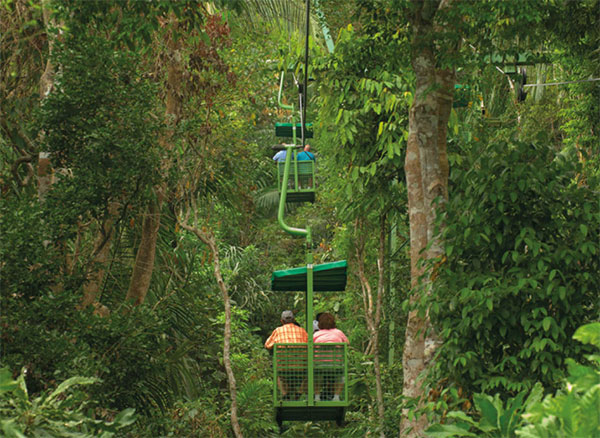Fact
The French attempt at building the Panama Canal, led by Suez Canal architect Ferdinand de Lesseps, was a disaster. Few foresaw the enormous challenges that the thick, mosquito-infested jungle presented, ranging from floods to yellow fever. In the end, more than 20,000 died before they called it quits.
There are several ecolodges within or on the border of the park, such as Canopy Tower (www.canopytower.com), which opened in 1999 in an ex-US-military radar station on top of Semaphore Hill. Topped by a 9 meter (29.5ft) high dome, views of the rainforest canopy give phenomenal access to bird watchers, making the lodge one of the region’s top destinations.

Rainforest aerial tram, Gamboa Rainforest Resort.
Getty Images
Gamboa, once a residential area for American workers in the canal’s dredging division, is on the shore of the Chagres River and home to the Gamboa Rainforest Resort (www.gamboaresort.com), a family-friendly lodge surrounded by the pristine forests of Soberanía. Less ecolodge than posh hotel, it’s a sprawling property that includes multiple pools and restaurants, plus a full range of in-house excursions like boat trips on Gatún Lake and guided hikes with naturalist guides.
Fact
While Panama hats were popularized by Ferdinand de Lesseps during the French canal effort, and later Theodore Roosevelt during the American one, they aren’t actually Panamanian. Rather, they’re made in the Manabí Province of Ecuador, using fibers from the toquilla palm, and have been a cottage industry since the 1600s. Lightweight and breathable, the hats were given to canal workers and have become associated with tropical locales.
Gatún Lake 6 [map] was created in 1913 when the Gatún Dam was built on the Chagres River, flooding 425 sq km (164 sq miles) of forest. The lake is home to several Emberá villages, which resettled here near the mouth of the Chagres River from the Darién Province. The villages of Parara Puru, Emberá Puru, and Emberá Drua have opened to tourism and visits have become a popular shore excursion for cruise visitors and other travelers in Panama. Most trips are half-day visits that include a typical Emberá lunch, a folkloric dance show, dugout canoe rides, and the chance – or pressure, some might say – to purchase Indigenous handicrafts. Most tour agencies in Panama City, including Ancon Expeditions and Advantage Panama, run tours here.

Cargo ship on Gatún Lake.
iStock
Colón province
Running along Panama’s central Caribbean coast, the province of Colón seems to have a culture all of its own. The Afro-Panamanian influence is strong here, deriving from laborers who arrived to work in the canal and those who then arrived during the days of slavery. The gritty capital is the city of Colón, the largest duty-free zone in the Americas, which has undergone a series of makeovers that have yet to truly clean it up. More remote are attractions like the Spanish Fort of San Lorenzo and the historic seaside village of Portobelo.
Colón and around
Founded in 1850 during the California Gold Rush, when crossing the isthmus via the Panama Railroad saved a trip around Cape Horn, Colón 7 [map] has seen its ups and downs. The city grew large in its early days, until its progress was halted by the establishment of the US transcontinental railroad in 1869. It then saw another bump thanks to French and later, American, canal work. It was during this period that much of the city was built, although the city has lingered in obscurity as Panama City has grown.
The city’s biggest industry is the Colón Free Zone on the southeastern edge of town. Here, nearly 2,000 showrooms sell a variety of goods tax-free, although it’s of little interest to passing tourists as it’s primarily aimed at wholesalers. Along the eastern shore is the cruise-ship port, Colón 2000, which has a few restaurants, a duty-free store, and handicraft shops. Much of the rest of the city can be dangerous and is best avoided.
Along the lake shore outside of town is the former Escuela de las Americas, a notorious military school known for training Manuel Noriega. It’s now an upscale Meliá hotel (www.meliapanamacanal.com).
Near the Caribbean entrance to the canal, 10km (6 miles) west of Colón, are the Gatún Locks, which have their own visitor center (daily 9am–4pm). While the facility lacks the amenities of the Miraflores Locks (for more information, click here), the viewing platform gives a great look at Panamax ships and tankers rising to the level of Lake Gatún. About 2km (1.2 miles) farther on is the Gatún Dam across the Chagres River, which was the largest in the world at the time it was built.
Passing over the Gatún Locks, the road leads through the dense jungles of the Sherman Forest Reserve to Fort Sherman, a former US military base that has been partially dismantled. The rough road continues 8.9km (5 miles) until the mouth of the Chagres River. Nearby, you will find Fort San Lorenzo (daily 9am–4pm), a Spanish fort that was first built in 1595, but sacked several times in pirate attacks. The current incarnation, a Unesco World Heritage Site, dates from 1761 and is in a relatively good condition, with a collection of rusty cannons and a grass-covered moat.